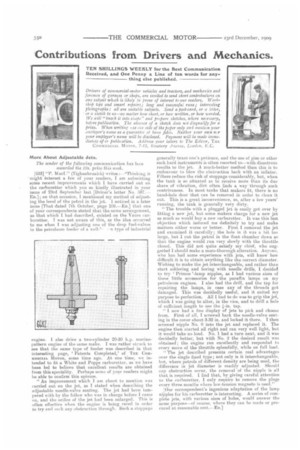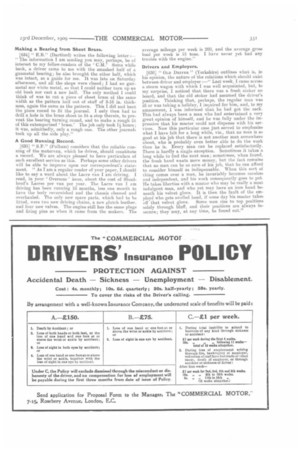Contributions from Drivers and Mechanics.
Page 18

Page 19

If you've noticed an error in this article please click here to report it so we can fix it.
TEN SHILLINGS WEEKLY for the Best Communication Received, and One Penny a Line of ten words for any thing else published.
Drivers of commercial-motor vehicles and tractors, and mechanics and foremen of garages or shops, are invited to send short contributions on any subject winch is likely to prove of interest to our readers. Workshop tips and smart repairs; long and successful runs ; interesting photographs : all are suitable subjects. Send a Post-card, or a letter, or a sketch to us—no matter how short, or how written, OY how worded, We will "knock it into shape" and prepare sketches, where necessary, before publicall'on. The absence of a sketch does not disqualify for a prize. When writing use one side of the paper only and mention your enat.loyer's name as a guarantee of bona fides. Neither your own rite your employer's name will be disclosed. Payment will he made imme. diately af er publication. Address your letters to The Editor, THE COMMERCLAL Mn ion, 7.75, kosebery Avenue, London, E.G.
More About Adjustable Jets.
The sender of the following communication has been awarded the 10s. prize this week.
[633] "P. Med." (Tighnabruaich) writes :—"Thinking it -might interest a few of your readers, I am submitting some recent improvements which I have cerried out on the carburetter which you so kindly illustrated in your issue of 23rd September last [Driver's letter No. 5S7.— En.]; on that occasion, I mentioned my method of adjusting the level of the petrol in the jet. I noticed in a later issue [That dated 7th October, page 109.—En.] that one of your correspondents stated that the same arrangement, as that which I had described, existed on the Veers carburetter. T was not aware of this, as the idea occurred to me when 1 was adjusting one of the drop fuel-valves
in the petroleum feeder of a en type of industrial engine. I also drive a two-cylinder 20-30 h.p. marinepattern engine of the seine make. I was rather struck to see that the same type of feeder was described in that interesting page, Patents Completed,' of Tee Commersciee MOTOR, some time ago. At one time, we intended to fit a White and Poppe carburetter, as we have been led to believe that exeellent results are obtained from this speciality. Perhaps some ef your readers might be able to confirm this opinion. " An improvement which I am about to mention was carried out on the jet, as I stated when describing the adjustable motile-valve seating. The jet had been tampered with by the fellow who was in charge before 1 came on, and the orifice of the jet had been enlarged. This is often effective when the engine is being raced in order to try and suck any obstruction through. Such a stoppage generally taxes one's patience, and the use of pins or other such bard instruments is often resorted to—with disastrous results to the jet. A much-better method than this is to endeavour to blow the obstruction back with an inflator. Filters reduce the risk of stoppage considerably, but, when the tank is so situated as to receive snore than its duo share of vibration, dirt often finds a way 'through such oontrivances. In most tanks that makers fit, there is no hand-hole door that can be removed in order to (lean it out. This is a great inconvenience, as, after a few years' running, the tank is generally very dirty.
"The trouble with a plugged jet is easily got over by fitting a new jet, but some makers charge for a new jet as much as would buy a new carburetter. It was this last
objection which induced me definitely to try and make matters either worse or better. First I removed the jet and examined it carefully ; the hole in it was a bit too large, but I cut the petrol in the float chamber down so that the engine would. run very slowly with the throttle closed. This did not quite satisfy my chief, who suggested I should make a more-thorough alteration. Anyone,
who has had some experience with jets, will know how difficult it is to obtain anything like the correct diameter.
Wishing to make the jet interchangeable, and rather than start soldering and boring with needle drills, I decided to try Primus '-lamp nipples, as I had various eizee of these little accessories for the paraffin lamps on my petroleum engines. I also had the drill, and the tap for repairing the lamps, in case any of the threads got damaged. This was decidedly useful, and it suited my purpose to perfection. All I had to do was to grip the jet, which I was going to alter, in the vice, and to drill a hole of sufficient length to use the k-in. tap. " I now had a fine display of jets to pick and choose from. First of all, I screwed back the needle-valve seat ing in the cover about 3-32 in. and locked it there. I then screwed nipple No. 0 into the jet and replaced it. The engine then started all right and ran very well light, but it would take no load. No. I had a turn next, and it was decidedly better, but with No. '2 the desired result was obtained ; the engine ran excellently and responded to every move of the throttle splendidly, while on full load. " The jet described presents certain real advantages over the single fixed type; not only is it interchangeable, but, where petrels of different density are being used, the difference in jet diameter is readily adjusted. Should any obstruction occur, the removal of the nipple is all
tb.at is required. I find that, by giving careful attention to the carburetter, I only require to remove the plugs every three months where low-tension magneto is used."
[Our correspondent's ingenious adaptation of the lamp nipples for his carburetter is interesting. A series of com plete jets, with various sizes of holes, would answer the same purpose—of course, where they can be made or procured at reasonable cost.—En.1 Making a Bearing from Sheet Brass.
L634] " E.B." (Dartford) writes the following letter " The information I am sending you may, perhaps, be of interest to my fellow-readers of the C.M.' Some while back, a driver came to me with the smashed, half of a gunmetal bearing ; he also brought the other half, which was intact, as a guide for me. It was late on Saturday afternoon, and all the shops were closed; I had no gunmetal nor white metal, so that I could neither turn up an old bush nor east a new half. The only method I could think of was to cut a piece of sheet brass of the same width as the pattern half out of stuff of 3-16 in, thickness, again the same as the pattern. This I did and bent the piece round to fit the journal. I only then had to drill a hole in the brass sheet to fit a stop therein, to prevent the bearing turning round, and to make a rough fit
of this extemporized brass.' The job only took hours ; it was, admittedly, only a rough one. The other journals took up all the side play."
A Good Running Record.
[635] " S.P." (Fulham) considers that the reliable running of the motorvan, which he drives, should constitute a record. We are always pleased to have particulars of such excellent service as this. Perhaps some other drivers will be able to improve upon our correspondent's statement. " As I am a regular reader of your paper, I should like to say a word about the Lacre van I am driving. I read, in your Overseas ' issue, about the cost of Shootbred's Laeres per van per year. The Lacre van I am driving has been running 16 months, less one month to have the body revarnished and the chassis cleaned and overhauled. The only new spare parts, which had to he fitted, were two new driving chains, a new elutch leather. and four new valves. The engine still has the same plugs and firing pins as when it came from the makers. The
average mileage per week is 260, and the average gross load per week is 15 tons. I have never yet had any trouble with the engine."
Drivers and employers.
[636] " OLD DRIVER " (Yorkshire) outlines what is, in his opinion, the nature of the relations which should exist between driver and employer:—' Last week, I came across a steam wagon with which I was well acquainted, but, to my surprise, I noticed that there was a fresh stoker on board, and that the old stoker had assumed the driver's position. Thinking that, perhaps, the regular man was ill or was taking a holiday, I inquired for him, and, to my amazement, was informed that he had got the sack. This had always been a man who bad entertained a very great opinion of himself, and he was fully under the impression that his master could not dispense with his services. Now this particular case just served to emphasize what I have felt for a long while, viz., that no man is so good at his job that there is riot another man somewhere about, who is probably even better able to do the work than he is. Every man can be replaced satisfactorily. There is hardly a single exception. Sometimes it takes a long while to find the next man ; sometimes, when found, the fresh hand wants more money, but the fact remains that no man can be so sure of his job, that he can afford to consider himself as indispensable. When this sort of thing comes over a man, he invariably becomes careless and independent, and his work consequently goes to pot. Fre takes liberties with a master who may be really a most indulgent man, and who yet may have an iron hand beneath his velvet glove. It is then the fault of the emp1oy6 who gets swelled head, if some day his master takes off that velvet glove. Some men rise to top positions solely through bluff, and their positions are always insecure; they may, at any time, be found out."




















